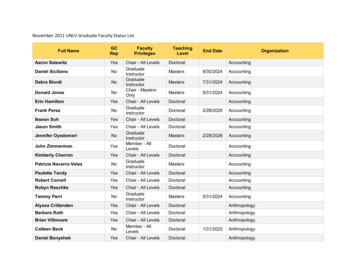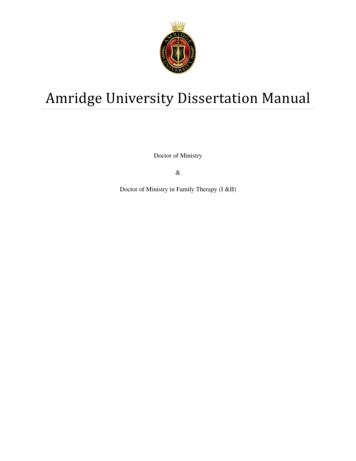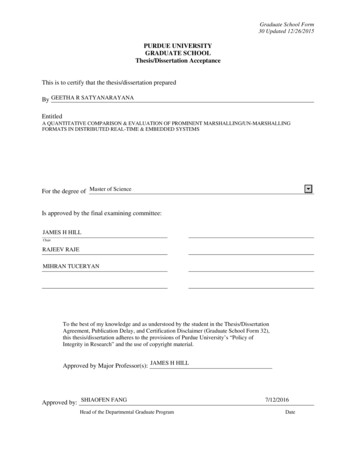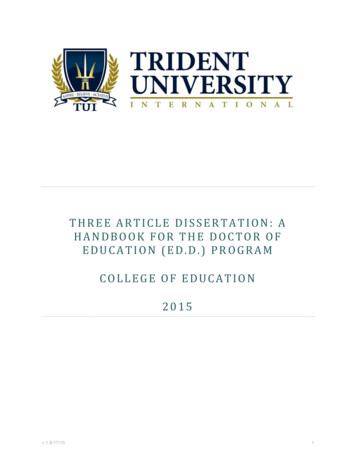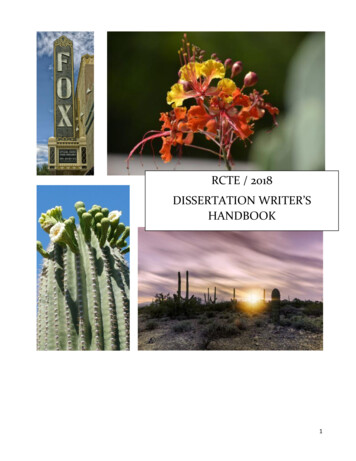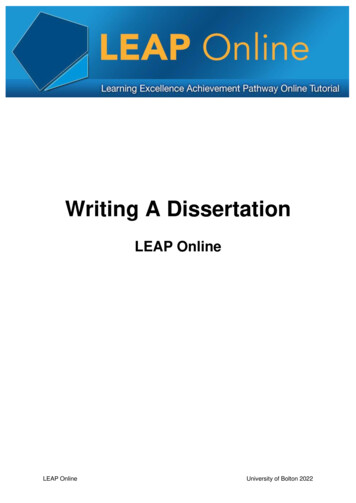
Transcription
Master’s Degree Dissertation Guidelines- 2019 of Faculty of Management, Tribhuvan UniversityMaster’s Degree Dissertation Guidelines- 2019Office of the Dean, Faculty of ManagementTribhuvan UniversityKathmandu, NepalEffective from 20191
Master’s Degree Dissertation Guidelines- 2019 of Faculty of Management, Tribhuvan UniversityTable of contentPageChapter- I: Introduction3Dissertation Guidelines3Dissertation3Research Committee Approval4Chapter- II; Research Ethics5Research Ethics5Chapter- III: Requirements7Requirements for Masters‟ dissertation7Regulation of FOM on Dissertation Writing7Proposal Writing7Dissertation Structure and Contents9Paper and Typography20Evaluation of the Dissertation21Appendices21Appendix- A; Regulation of FOM Dissertation Writing21Appendix-B: Format of Preliminary Materials23Appendix-C: Guidelines for Table and Figures272
Master’s Degree Dissertation Guidelines- 2019 of Faculty of Management, Tribhuvan UniversityCHAPTER- I: IntroductionDissertation GuidelinesThese dissertation guidelines have been created as a guide to help Master‟s level studentsestablish minimum requirements, academic standards, the physical format and appearance ofdissertation. The purpose is to provide academic requirements and structural guidelines requiredfor dissertation writing to the students under the Faculty of Management (FOM), TribhuvanUniversity (TU). The FOM encourages the preparation of documents to be consistent with thespecialized requirements prior to the submission. Submission of this document is the final step ina program leading to conferral of a Master‟s degree.DissertationA dissertation is a formal academic document following the rules that govern the way in which itis presented. It must have chapters that provide an introduction, a literature review, a justificationof the data selected for analysis and research methodology, analysis of the data and, conclusionsand recommendations. Advice on the range of suitable topics which relate to the subject area ofyour Master‟s degree will be approved by the dissertation supervisor and research committee.The dissertation is the final stage of the Master‟s degree and provides you with the opportunity toshow that you have gained the necessary skills and knowledge in order to organize and conduct aresearch project. It should demonstrate that you are skilled in identifying an area, or areas,suitable for research: setting research objectives; locating, organizing and critically analyzing therelevant secondary data and authoritative literature; developing an appropriate researchmethodology; analyzing the primary data selected and drawing on the literature in the field;drawing conclusions; and if appropriate making relevant recommendations and indications ofareas for further research.3
Master’s Degree Dissertation Guidelines- 2019 of Faculty of Management, Tribhuvan UniversityResearch Committee ApprovalDissertation is an academically admirable professional document and should meet academicvigor and professionally standard in content and appearance. The office of the dean, FOM hasestablished guidelines to ensure uniformity in style and format, and your dissertation must meetthese standards to be approved.Student Responsibility: It is the students‟ responsibility to read and fulfill the requirementspresented here and to submit the dissertation maintaining the quality. Correct grammar,punctuation, and spelling always should be used, and these aspects are the responsibility of thestudent. Please consult your supervisor and committee chair for specific content requirements.Proofreading is the responsibility of the student and his/her supervisor.Style: Most format requirements in the FOM dissertation guidelines take precedence over formatrules found in the other style guidelines. Format includes definition of the parts of the thesis andthe order in which they must appear the content of the prefatory pages, the type font, marginsand spacing, the placement of the page numbers, and the requirements for permission toreproduce copyrighted material. The FOM will recommend a student for the degree sought onlywhen the dissertation completely satisfies the requirements stated in these guidelines.4
Master’s Degree Dissertation Guidelines- 2019 of Faculty of Management, Tribhuvan UniversityCHAPTER II: Research EthicsResearch EthicsEthical issues have come in forefront in the research writing. All students have aresponsibility to conduct and report the results of their research in ethical manner. Thedissertation represents the culmination of years of academic preparation and expresses astudent‟s ideas, training and skills. The dissertation therefore deserves the student‟s effortand with all scholarly work, demands obedience with highest ethical standards.Fabrication, falsification and plagiarism in proposing, conducting or reporting research orother scholarly activities are ethical misconduct in research. Fabrication means makingup results and falsifying research results refers to altering, misrepresenting, or selectivemisquoting of the findings. Each of these activities violates the integrity of the researchprocess and constitutes a serious breach of accepted ethical standards. Ethical researchpractice therefore requires that students at all stages of the research process conduct theirresearch in honest manner and make every effort to ensure the accuracy of their findings.Plagiarism is a form of ethical misconduct in research and consists of the intentional orunintentional use of the words, ideas, diagrams of publicly available work withoutappropriately acknowledging the sources of these materials. Thus, any use of the words,phrases, ideas, or work of others in any form without acknowledgement of the originalsources constitutes plagiarism and is subject to penalty. Students must be aware toacknowledge the contents of literature review, the ordering of ideas in the discussion, andthe listing of references at the end of a discussion, which may reflect the thinking ofothers. These contributions must be acknowledged and cited.Therefore, the researchers are advised to be conscious on ethical issues particularly in thefollowing:5
Master’s Degree Dissertation Guidelines- 2019 of Faculty of Management, Tribhuvan University Data retention and sharing. It is the duty of the researcher to retain and share the dataused in the study. The researcher must produce every bit of data to the supervisor whileworking on the research. The researcher must keep them ready at the time of viva voceand produce as evidence on demand. Plagiarism. Plagiarism is, as stated earlier, claiming others‟ words and ideas as yourown. It is strictly prohibited. The researcher must take permission for all copyrightmaterials. S/he can refer other researchers‟ writings in her/his dissertation, but the creditto the source must be given in the text and list in the list of references. Protecting confidentiality: During the research, the researcher may have access toconfidential information of a person or an institution. It is the duty of the researcher tomaintain the confidentiality of the of the person or the institution.6
Master’s Degree Dissertation Guidelines- 2019 of Faculty of Management, Tribhuvan UniversityCHAPTER III: RequirementsRequirements for Master’s DissertationA master‟s thesis is a substantial document presenting independent research that makes acontribution to the current body of knowledge in a scholarly field. The author may conduct anoriginal investigation or develop an original interpretation of existing research and/or literature.A dissertation adheres to a standard format, generally with several basic chapters that mayinclude an introduction and statement of the problem, a review of the literature pertinent to theproblem, an explanation of the materials and methods used to solve the problem, a resultssection, a discussion of the results, and a conclusion. A formal list of references cited in thedissertation also is required. The dissertation must be formatted to conform to the FOMspecifications as stated in these Guidelines.This guideline consists of (1) dissertation writing regulations prescribed by FOM, (2) basiccomponents of the proposal for dissertation writing, (3) dissertation structure and contents, (4)dissertation layout, (5) research ethics, (6) evaluation of dissertation, and (7) appendixes.Please note, this is only a guidelines that students must read as a guid book on ResearchMethodology and students are required to consult his/her dissertation supervisor foradditional support.Regulations of Faculty of Management on Dissertation WritingEvery student writing master‟s dissertation must comply with the regulations set by theFaculty of Management (FOM), Tribhuvan University. These regulations relate to thelanguage of dissertation writing, dissertation completion period, and the grade. Students areadvised to go thoroughly the updated regulations available at the official website of theFOM. (The current one is appended in Appendix A).7
Master’s Degree Dissertation Guidelines- 2019 of Faculty of Management, Tribhuvan UniversityProposal WritingThe dissertation proposal describes what the researcher intends to do and how it will be done.It should outline in clear terms the nature and intent of the research. The proposal works as aroad map in the journey of research. Students must submit a dissertation proposal to theResearch Department/ Research Management Cell (RMC) in their campus/ college. Onceapproved, the student will have to prepare the report as outlined in the proposal.In the process of writing a proposal, the first step is to identify the possible area of the study.In the second step, students should do the preliminary review of literature in the chosen areaof the study and raise some issues for investigation. In the next step, it is important toexamine whether data will be available on the chosen topic or not. Finally, it is wise toevaluate possible obstacles (e. g. the study will take too long time to complete, or requireslong-distance travel, or involves health hazard, etc.) in carrying out research on the chosenarea.If everything goes fine to this point, the researcher can finalize the title for the research work.The title of the dissertation should reflect the main idea of the research work. The title shouldbe concise but should incorporate significant variables in the study and their relationship. Anexample of good title is “Credit Risk and Profitability of Commercial Banks in Nepal.”Always avoid using abbreviations and verbose terms (e. g. “A Study of , An Investigationinto , An Understanding of ” in the title. It is generally suggested to limit the length ofthe title within 12 words. The approximate length of the proposal is 8-12 pages. The proposalshould be written in the following structure:i.Background of the studyii.Problem statementiii.Objectives of the studyiv.Hypothesis (if any)v.Rationale of the studyvi.Brief review of the literaturevii.Research methodology8
Master’s Degree Dissertation Guidelines- 2019 of Faculty of Management, Tribhuvan University1.1.1Research design1.1.2Population and sampling procedure1.1.3Nature and sources of data collection1.1.4Research framework and definition of variables1.1.5Methods of analysisReferencesDissertation Structure and ContentsA dissertation typically is made up of three main sections:Prefatory sectionBody of the dissertation sectionSupplementary materials sectionA. Prefatory section. This section is organized in the following order: Title page of the dissertation Certification of authorship Report of Research Committee Approval sheet Acknowledgments Table of contents List of tables List of figures Abbreviations Abstract(The formats of the above contents of preliminary materials are provided in Appendix B.)9
Master’s Degree Dissertation Guidelines- 2019 of Faculty of Management, Tribhuvan University Abstract: An abstract is a brief but comprehensive summary of thedissertation. It is the first section to be read and should be the last to bewritten. It should enable the reader to make an informed decision aboutwhether they want to read the whole report. The length will depend on theextent of the work reported but it is usually a paragraph or two and alwaysless than a page. While writing an abstract, begin with most importantpoints (e. g. the problems under investigation or the objectives). Statemethodology briefly. Report major findings, conclusions and theirimplications. A good way to write an abstract is to think of it as a series ofbrief answers to questions. These would probably include: What is the purpose of the work? What methods did you use for your research? What were the main findings and conclusions reached as aresult of your research? Did your work lead you to make any recommendations forfuture actions?Write in a clear and concise language, use active voice, use present tenseto describe conclusions, use past tense to describe specific variablesmanipulated or outcomes measured. Do not include information that doesnot appear in the body of the report, do not comment or evaluate inabstract. At the bottom of the abstract, provide key words (not more thanfive) that truly reflects the research. Limit the abstract in one page.B. Body of the report section. This section is divided into five chapters. Thecontents of each chapter are given below. In exceptional cases, the sectionswithin a chapter may be altered/ added/ or deleted upon the advice of thesupervisor; but that must be justified by the need of the study. The content ofeach chapter is organized in the following order:10
Master’s Degree Dissertation Guidelines- 2019 of Faculty of Management, Tribhuvan UniversityChapter I IntroductionBackground of the study. The purpose of this section is to create the context to thestudy. This section should describe about the core aspect of the topic and clearlyestablish the focus of study. It should be written based on factual information on thetopic and the institutions under study. Therefore, it is important that the researcherhas sufficient idea and factual information on the topic. There is no specific limit tothe length of this section, but 2-3 pages should suffice. Problem statement. The purpose of this section is to establish research issues. It iscore part of the introduction chapter. Remember, problem statement is not the listingof „difficulties‟ or „problems. It is the statement of why the situation (e. g. therelationship – improved or worsened - between variables exists). Therefore, it isimportant that problem statement must be supported by evidence coming from thereview of literature. Evidences from the literature justify why the research problem isworth investigating. Problem statement section normally ends by raising researchquestions. The researcher should demonstrate with adequate review of both theoryand empirical researches that the problem that have been chosen for the study isvaluable to the readers. Normally 2-4 pages are enough for this section. Objectives of the study. Objectives of the study specifies what the researcher intendsto do. It is customary to state general objective of the research in one or twosentences, then list the specific objectives. In fact, specific objectives are conversionof research questions into a to-do list, and general objective is the reflection of all thespecific objectives. There are a few guidelines on the use of action verb in settingobjectives. Use action verbs (like to examine, analyze, assess, compare, etc.) that canreally be performed in the study. Words like to know, see, understand, etc. aregenerally avoided to frame objectives as they are difficult to realize. Hypotheses (if any). Research questions posed in Problem Statement section requiresanswers. Hypotheses testing is one concrete way of answering those questions. If theresearcher has chosen this approach to answering the questions, the hypotheses haveto be stated in this section.11
Master’s Degree Dissertation Guidelines- 2019 of Faculty of Management, Tribhuvan University Rationale of the study. In this section, the researcher should state why this study isworthwhile and useful to the readers. The study could add to existing knowledge,improve current practices or add to policy making. Be specific and honest.Unjustified claims reduce the value of the research. Limitations of the study. Limitations inhibit the generalizability and applicability of theresearch findings. But then, it is always good to acknowledge them. They signal warningsto the readers on the applicability of the study. The researcher should differentiatebetween the scope of the study and the limitations of the study. Scope specifies the areaof the study; limitations arises within the scope. Issues not covered in the scope are notthe limitations.Chapter IILiterature ReviewThe purpose of this chapter is to review related literature in order to develop fullerunderstanding on the topic. It gives the researcher an opportunity to develop skill onlocating resources, scanning and critically evaluating the literature, and organizing themin a well-organized manner. Before actually embarking on this activity, it is importantthat the researcher must thoroughly learn “how to review”, otherwise, it is likely that theresearcher may lost in jungle of the literature. There is no strict limit to the page numberto this chapter, but as a guide, 10 to 20 pages should suffice.This chapter begins with an introduction which create a link between Chapter I andremainder of this Chapter. It also should provide an overview of the organization of thesecond chapter. Introduction is followed by theoretical review. As its name implies,this section is meant to review theoretical underpinning on the topic of the research. Butat master‟s level dissertation, it is equally useful to review literature related to conceptualaspects of the topic. Review of recent research articles and reports related to the topic ofthe research, often dubbed as empirical review, should follow the theoretical review.The researcher should identify the key issues investigated by the study, check themethodology followed, and note the key findings of the study. Literature related to thegovernment policy, regulations and any other relevant aspects of the study should also becovered in this section. The review of literature should clearly establish with evidencethat there exists research gap.12
Master’s Degree Dissertation Guidelines- 2019 of Faculty of Management, Tribhuvan UniversityIn review, researchers use others‟ resources (texts, data, idea, etc.) for their own purpose.Therefore, it is essential to give credit to the original authors. There are specific ways ofcrediting them in the text and listing the materials in the list of references. Faculty ofManagement follows the APA style of citation and referencing. Therefore, researchersare advised to check Publication Guidelines of the American Psychological Association,(sixth edition) for details. Frequently asked questions about the Publication Guidelines ofthe American Psychological Association (APA) are available at:http://www.apastyle.org/faqs.htmlChapter IIIResearch MethodologyWhat sets apart the research writing with other forms of writing is that research writingclearly spells out in the report the set of research methods followed while carrying out theresearch. It makes the research writing „scientific‟ and allows other researchers to verifythe findings, if they wish, by following the same set of methods. This is the reason why aseparate chapter/section is devoted to the research methodology in every research report.This chapter opens up with an introduction and includes (i) research design, (ii)population and sample, and sampling design, (iii) nature and sources of data, and theinstrument of data collection, (iv) methods of analysis, and (v) research framework anddefinition of variables.State the research design (exploratory, descriptive, comparative, interventional,qualitative) followed in the study. Clearly identify the population of the study and drawsamples representative to the population. Be careful while selecting the samplingtechnique (random, stratified, purposive, conveyance, etc.); only appropriate samplingtechnique ensures representativeness of the sample. Specify whether primary orsecondary or both types of data have been used. Also specify the sources, methods andinstruments of data collection. Mostly, a set of tools (e. g. financial, statistical) are used toanalyze the data. In some cases, models are used in the analyses. They must be spelt outin this section. Finally, the research framework should be developed to streamline theresearch process. The review of theory and evidences from the empirical studiesreviewed in the second chapter should guide the development of the research framework13
Master’s Degree Dissertation Guidelines- 2019 of Faculty of Management, Tribhuvan Universityof the study. The researcher should clearly identify the variables, define them andestablish their interrelationship at this point.Chapter IVResults and DiscussionIn this chapter data are presented in appropriate format, then analyzed and discussed. Theanalysis should seek to answer the research questions posed or test the hypotheses set inthe introduction chapter. The outcomes of the analyses are the results. The results arethen discussed and interpreted in the light of theories and empirical studies to arrive atconclusion. Accordingly, this chapter is organized in the following order: Results DiscussionResults. In the Results section, the researcher should present and analyze the collecteddata to extract their meaning. Tables, and figures (brief guidelines for the preparation of atable and figure are presented in Appendix C) are useful for meaningful presentation ofdata. Analysis of data and the reporting of the results of those analyses are fundamentalaspects of doing research. Thereforethe researcher, sometimes, aggregates and someother time breaks down data in pieces for analysis purpose. Different methods and toolsof analyses are available. In some studies, (e. g. a descriptive type of study), simplepercentage analysis or a ratio analysis would suffice. Others may require simple tocomplex statistical analyses. When reporting the inferential statistical tests or whenproviding estimates of parameters, include sufficient information to help the reader tofully understand the analyses. For inferential statistical tests (e. g., t, F, and χ2 tests),include the obtained value of the test statistic, the degree of freedom, etc. Use themproperly, inappropriate selection of the tools spoils the researcher‟s efforts. This sectionshould seek to answer all the research questions and test the hypotheses. Organize theresults section in a number of subsections to cover each aspect of the study.Discussion. In this section the researcher evaluates and interprets the results. Here theresearcher examines every aspect of the results in terms of related theories and empiricalfindings of other researchers. The researcher should discuss why the findings areconsistent or inconsistent as predicted by the theory,compare the results with that of otherresearchers and try to explore the reasons for the similarity or the contradiction. While in14
Master’s Degree Dissertation Guidelines- 2019 of Faculty of Management, Tribhuvan Universitythe results section the researcher has to analyze the data, here in the discussion section,s/he has to synthesize the findings of the study. The researcher has to interpret the resultsin right perspective and offer evidences wherever necessary. While interpreting theresults, care should be given to sources of potential bias, the imprecision of measures, theeffect of sample size, and other methodological limitations and weaknesses. Thediscussions in this section should clearly lead to arrive at the conclusion and implicationof the study that is deferred to next section.Chapter VSummary and ConclusionThe purpose of this chapter to present an overview of the study in the summarized formalong with major findings and the conclusion of the study. Accordingly, it is organized inthree sections:Summary. As its purpose is to provide an overview of the study, it should cover a verybrief introduction and justification of the study. Then it should give the general objectiveof the study and describe the methods followed in the research process. Then it shouldreport the key findings based on the analysis and discussion section. Organize findings ina purposeful manner so that they answer the research questions, support or negate thehypotheses, and lead to conclusion.Conclusion. In this section, the researcher wraps up the things by telling the readers whatwas learned from the research.The researcher should draw the conclusion only from thefindings of the study. Number of findings may lead to one conclusion. At this point s/hemay use interpretation of the findings and give meaning to them. The researcher‟s logicalinterpretation of the findings leading to new knowledge makes the research original.Implications. The research may have number of implications to policy makers,practitioners and academic community. They may be reported as recommendations andareas for future research.Supplementary sectionThe purpose of this section is to provide a space for materials that are relevant to theresearch work but their inclusion in the main text distract the readers. Some materialseven work as the evidence to what has been presented or discussed in the text. The most15
Master’s Degree Dissertation Guidelines- 2019 of Faculty of Management, Tribhuvan Universitycommon materials placed in this section are the list of references consulted for theresearch purpose and data set used for analysis.References. The researcher extensively uses reference materials while writing researchreport. These reference materials are required to be listed as part of the research work.The purpose of reference list is to provide information necessary to identify and retrieveeach source and give due credit to the works of others which are quoted in the presentwork. A list of reference materials so presented is termed as references or works cited andfollows just after the main text of the report. Specifically, reference list contains onlythose sources that are cited in the research work. Faculty of Management follows theAPA style of referencing. Therefore, researchers are advised to check PublicationGuidelines of the American Psychological Association, (sixth edition) fordetails.Frequently asked questions about the Publication Guidelines of the AmericanPsychological Association (APA) are available at: http://www.apastyle.org/faqs.htmlInformation about using the Publication Guidelines of the American PsychologicalAssociation (APA) and examples of citation styles as well as information about planning,preparing, and writing a master‟s dissertation are also available u/owl/research and citation/apa style/apa formatting and style guide/general format.htmlDocumentation with exampleBooksGeneral FormatAuthor, A. A. (year of publication). Book title. Publisher‟s Location: Publisher.One AuthorGardner, J. (2016). Computer Science. Broomall, PA: Mason Crest.Two AuthorsFaulkner, S. L., & Squillante, S. (2016). Writing the personal: Getting your stories onto thepage. Rotterdam, The Netherlands: Sense Publishers.Three to Seven AuthorsIf a book has three, four, five, six, or seven authors, list all authors‟ names.16
Master’s Degree Dissertation Guidelines- 2019 of Faculty of Management, Tribhuvan UniversityHewson, C., Vogel, C. M., & Laurent, D. (2016). Internet research methods (2nd ed.). LosAngeles: SAGE.More than Seven AuthorsIf a book has eight or more authors, list the first six authors, then insert three ellipses andadd the last author‟s name.Browder, D., Spooner, F., Ahlgrim-Delzell, L., Al Otaiba, S., Allor, J., Bethune, K.S., Wood, C.L. (2014). More language arts, math, and science for students with severedisabilities. Newburyport, MA: Brookes Publishing.One Editor or Compiler as only authorConstantakis, S. (Ed.). (2016). World of Forensic Science (2nd ed.). Farmington Hills, MI:Gale Cengage Learning.Two Editor Edited BookButterfield, A., & Ngondi, G.E. (Eds.). (2016). A dictionary of computer science (7th ed.).Oxford, United Kingdom: Oxford University Press.No Author or EditorIf a book has no author or editor, place the title first and publication year after the title.Webster’s Spanish-English dictionary for students. (2010). Springfield, MA: Federal StreetPress.Book with an Author and an EditorTwain, M. (2014). Mark Twain on potholes and politics: Letters to the editor. G.Scharnhorst (Ed.). Columbia, MO: University of Missouri.Chapter from a Book / Items in an AnthologyInclude chapter author, date of publication, chapter title, book editor(s), book title, chapterpage numbers, place of publication, and the name of the publisher.Baron-Cohen, S. (2015). Radical Behaviorism. In J. Brockman (Ed.), This idea must die(pp. 204-207). New York: Harper Perennial.Encyclopedia ArticleEdwards Aquifer. (2011). In A. E. Gates & R. P. Blauvelt (Eds.), Encyclopedia ofPollution (Vol. 1, pp. 203-206). New York: Facts on File.Group or Corporate Author (author is same as publisher)American Diabetes Association. (2015). The Diabetes dictionary: What every person withDiabetes needs to know. Alexandria, VA: Author.Government Agency as AuthorU.S. Census Bureau. (2006). Statistical abstract of the United States (125th ed.). U.S.Government Printing Office.PERIODICALS (Magazines, Journals, and newspapers)General Format17
Master’s Degree Dissertation Guidelines- 2019 of Faculty of Management, Tribhuvan UniversityAuthor, A. A. (date of publication). Title of article. Title of Periodical, volume number,pages.Magazine ArticleGrossman
Faculty of Management (FOM), Tribhuvan University. These regulations relate to the language of dissertation writing, dissertation completion period, and the grade. Students are advised to go thoroughly the updated regulations available at the official website of the FOM. (The current one is appended in Appendix A).


